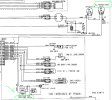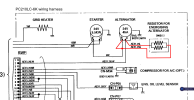husabetunia
New Member
Hi!
A new owner of older Komatsu excavator here and struckling with alternator wiring harness.
The machine has an aftermarket alternator (Prestolite 66021507) and it does not start charging without little 'kick', meaning that I have to excite the alternator a litle extra with a voltage testing pen to get it doind it's job (by testing between the battery positive and indicator lamp connector).
So, I checked on the wiring schematics and found out that the charging indicator wiring has a resistor unit in it and I wonder if that unit is faulty. At the moment I am reading only +2 VDC at the indicator pole before engine start up.
Do you happen to know where exactly this resistor unit should be located at the machine? Somewhere in the engine bay or inside the cabine maybe? According the schematics it should be inside the engine bay, before the SWP connector, right?
Thanks a lot!

A new owner of older Komatsu excavator here and struckling with alternator wiring harness.
The machine has an aftermarket alternator (Prestolite 66021507) and it does not start charging without little 'kick', meaning that I have to excite the alternator a litle extra with a voltage testing pen to get it doind it's job (by testing between the battery positive and indicator lamp connector).
So, I checked on the wiring schematics and found out that the charging indicator wiring has a resistor unit in it and I wonder if that unit is faulty. At the moment I am reading only +2 VDC at the indicator pole before engine start up.
Do you happen to know where exactly this resistor unit should be located at the machine? Somewhere in the engine bay or inside the cabine maybe? According the schematics it should be inside the engine bay, before the SWP connector, right?
Thanks a lot!


